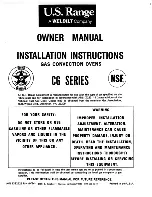
1 0 9
W HAT ARE M ICRO W AV ES?
a metal alloy base, which allows food to be browned.
W hen using the browning dish a suitable insulator,
e.g. a porcelain plate, must be placed between the
turntable and the browning dish. Be careful to adhere
e xa c tly to the p re -he a ting time g ive n in the
manufacturer’s instructions. Excessive pre-heating can
damage the turntable and the turntable stand or can
trigger the safety-device which will switch off the oven.
METAL
Generally speaking, metal should not be used, since
microwaves do not pass through metal and therefore
c a nno t re a c h the fo o d . The re a re , ho w e ve r,
exceptions: small strips of aluminium foil may be used
to cover certain parts of the food, so that these do not
thaw to o quickly o r beg in to co o k (e.g . chicken
wings).Small metal skewers and aluminium containers
(e.g. o f ready- co o ked meals) can be used. They
must, however, be small in relation to the food, e.g.
aluminium containers must be at least
2
/
3
to
3
/
4
filled
with food. It is recommended that you transfer the
food into a dish suitable for use in the microwave.
W hen using aluminium co ntainers o r o ther metal
ute nsils the re must b e a g a p o f a ppro x. 2 c ms
between them and the walls o f the co o king area,
otherwise the walls could be damaged by possible
arcing.
NO UTENSIL SHOULD HAVE A METAL
OVERLAY -
parts such as screws, bands or handles.
UTENSIL SUITABILITY TEST
If yo u are no t sure whether yo ur utensil
is suitable fo r use in yo ur micro wave
o ven, carry o ut the fo llo wing test: Place
the utensil into the o ven. Place a glass
co ntainer filled with 1 5 0 ml o f water
o n o r next to the utensil. Switch o n the o ven at 8 0 0
W po wer fo r 1 to 2 minutes. If the utensil stays co o l
o r just warm to the to uch, it is suitable. Do no t use
this test o n a plastic utensil. It co uld melt.
Microwaves are generated in the microwave oven
by a magnetron and cause the water molecules in
the food to oscillate.
GLASS AND CERAMIC GLASS
Hea t-resista nt g la ss utensils a re very
suitable. The co o king pro cess can be
observed from all sides. They must not,
ho wever, co ntain any metal (e.g. lead
crystal), nor have a metallic overlay (e.g. gold edge,
cobalt blue finish).
CERAMICS
Generally very suitable. Ceramics must be glazed,
since with unglazed ceramics moisture can get into
the ceramic. Moisture causes the material to heat up
and may make it shatter. If yo u are no t certain
whether yo ur utensil is suitable fo r the micro wave,
carry out the utensil suitability test.
PORCELAIN
Very suitable. Ensure that the po rcelain do es no t
have a go ld o r silver o verlay and that it do es no t
contain any metal.
PLASTIC AND PAPER UTENSILS
Heat resistant plastic utensils which are suitable for
use in the microwave can be used to thaw, heat and
c o o k fo o d . Fo llo w the ma nufa c ture r’ s
recommendations.
Heat-resistant paper made for use in a microwave
o ven is also suitable. Fo llo w the manufacturer’s
recommendations.
MICROWAVE FOIL
This, or heat-resistant foil, is very suitable for covering
o r wra pping . Plea se fo llo w the ma nufa c turer’s
recommendations.
ROASTING BAGS
Can be used in a microwave oven. Metal clips are
not suitable for fastening them since the roasting bag
foil might melt. Fasten the roasting bag with string
and pierce it several times with a fork. Non heat-
resistant food wraps are not recommended for use in
a microwave oven.
BROWNING DISH
A special microwave dish made from ceramic glass with
Heat is generated by the friction which is caused,
with the result that the fo o d is thawed, heated o r
cooked.
SUITABLE O V EN W ARE
















































